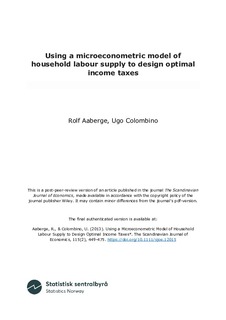| dc.contributor.author | Aaberge, Rolf | |
| dc.contributor.author | Colombino, Ugo | |
| dc.date.accessioned | 2019-02-28T14:07:44Z | |
| dc.date.available | 2019-02-28T14:07:44Z | |
| dc.date.issued | 2013-04-10 | |
| dc.identifier.citation | Aaberge, R., & Colombino, U. (2013). Using a microeconometric model of household labour supply to design optimal income taxes*. The Scandinavian Journal of Economics, 115(2), 449-475. doi:10.1111/sjoe.12015 | nb_NO |
| dc.identifier.issn | 1467-9442 | |
| dc.identifier.uri | http://hdl.handle.net/11250/2588097 | |
| dc.description | "This is the peer reviewed version of the article, which has been published in final form at https://doi.org/10.1111/sjoe.12015 This article may be used for non-commercial purposes in accordance with Wiley Terms and Conditions for Use of Self-Archived Versions." | nb_NO |
| dc.description.abstract | With regards to empirical applications of optimal taxation theory, analytical expressions are typically adopted for optimal taxes, and then numerical values are imputed to their parameters by calibration or by using previous estimates. We aim to avoid the restrictive assumptions and possible inconsistencies of this approach. In contrast, we identify optimal taxes by iteratively running a microeconometric model, based on 1994 Norwegian data, until a given social welfare function is maximized, given the public budget constraint. The optimal rules envisage monotonically increasing marginal rates (negative on very low incomes) and – compared to the current rule – a lower average rate, lower marginal rates on low incomes, and higher marginal rates on very high incomes. | nb_NO |
| dc.language.iso | eng | nb_NO |
| dc.publisher | John Wiley & Sons. | nb_NO |
| dc.rights | Navngivelse 4.0 Internasjonal | * |
| dc.rights.uri | http://creativecommons.org/licenses/by/4.0/deed.no | * |
| dc.subject | Microsimulation | nb_NO |
| dc.subject | Optimal taxation | nb_NO |
| dc.subject | Random utility model | nb_NO |
| dc.subject | Labour supply | nb_NO |
| dc.title | Using a microeconometric model of household labour supply to design optimal income taxes | nb_NO |
| dc.type | Journal article | nb_NO |
| dc.type | Peer reviewed | nb_NO |
| dc.description.version | acceptedVersion | nb_NO |
| dc.rights.holder | John Wiley & Sons. | nb_NO |
| dc.subject.nsi | VDP::Samfunnsvitenskap: 200::Økonomi: 210 | nb_NO |
| dc.source.pagenumber | 449-475 | nb_NO |
| dc.source.volume | 115 | nb_NO |
| dc.source.journal | The Scandinavian Journal of Economics | nb_NO |
| dc.source.issue | 2 | nb_NO |
| dc.identifier.doi | https://doi.org/10.1111/sjoe.12015 | |
| dc.relation.project | U. Colombino received financial support from the Italian Ministry of University and Research and the Compagnia di San Paolo. ICER is gratefully acknowledged for providing financial support. | nb_NO |

